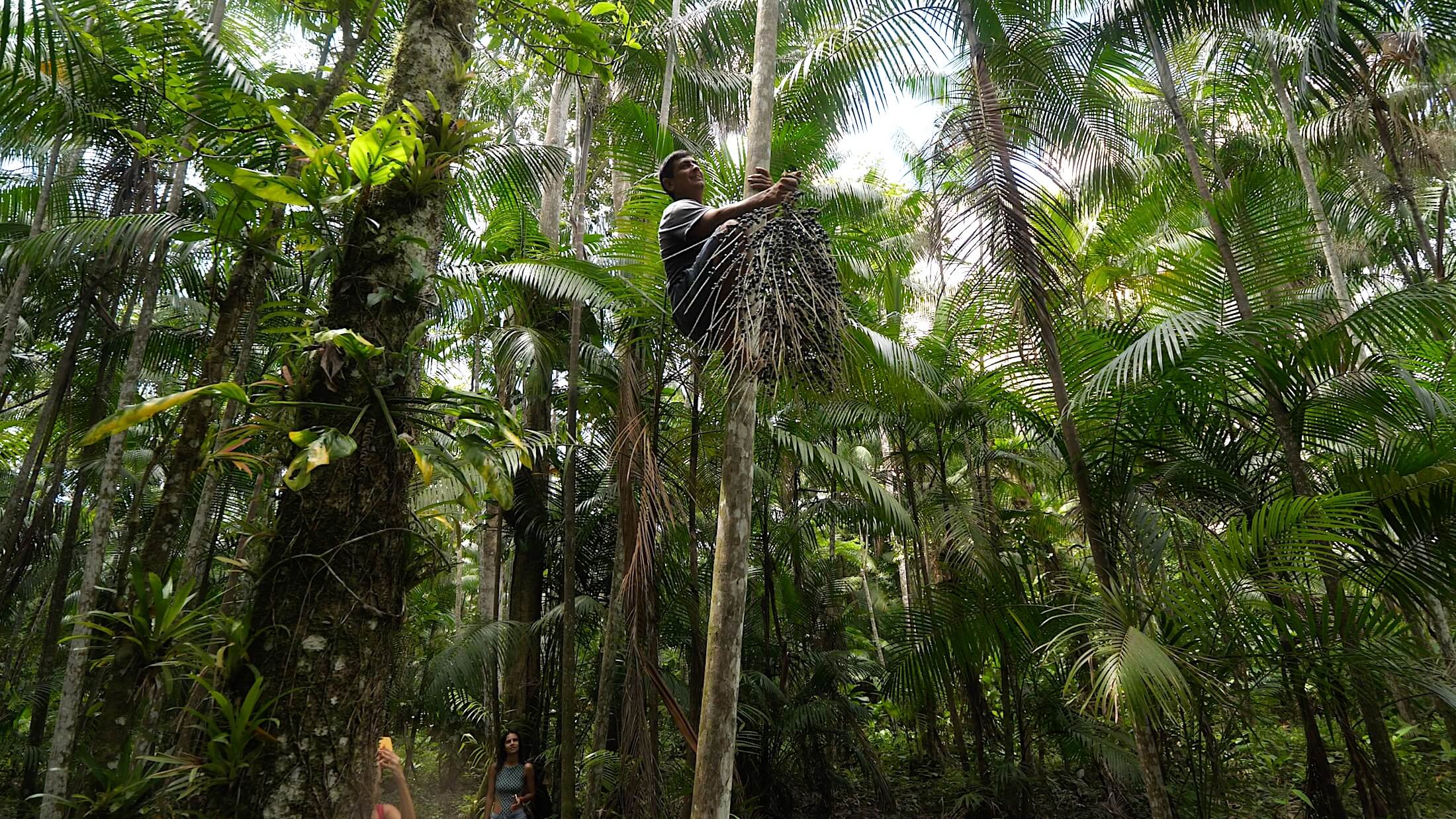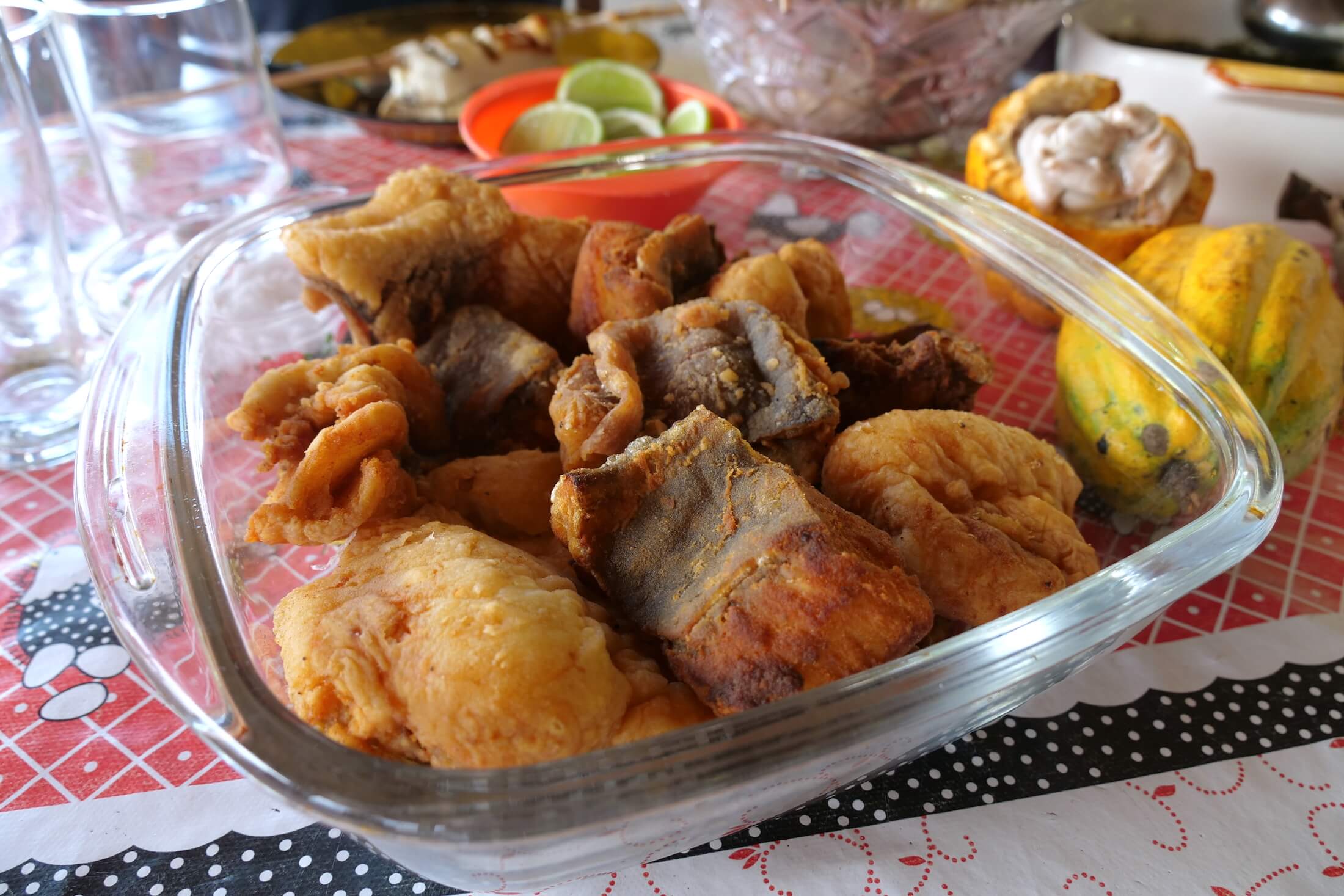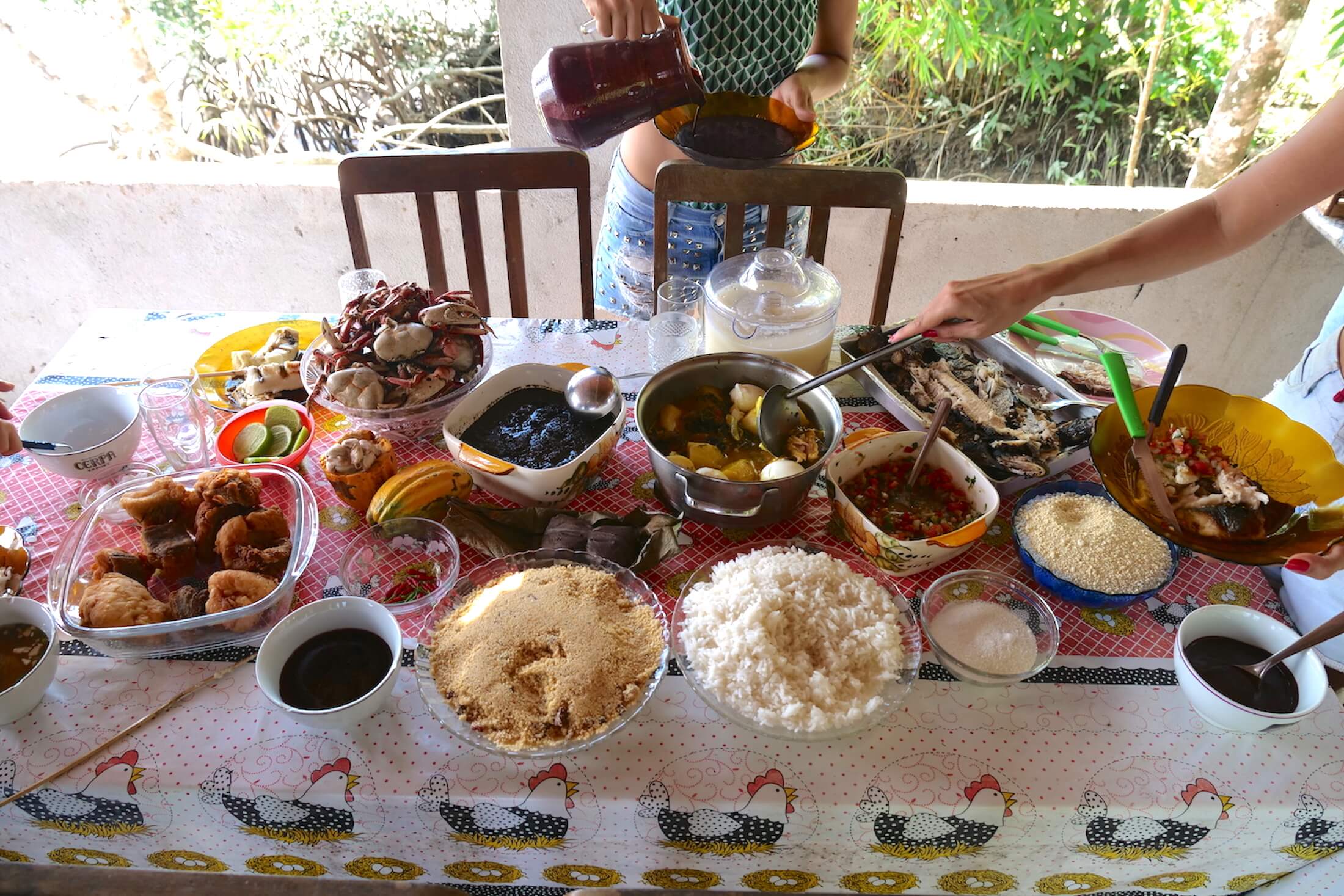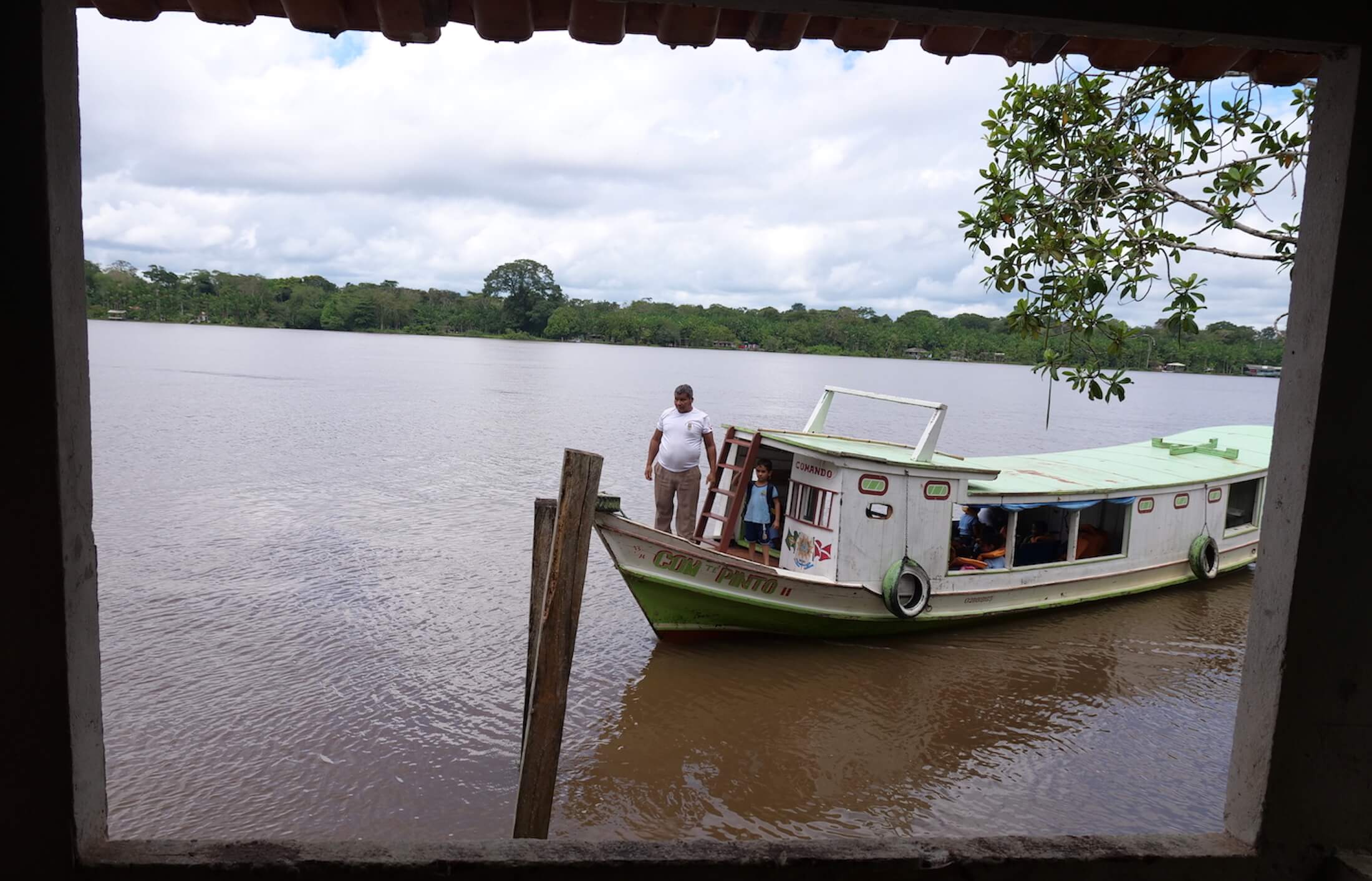
Açaí is a small purple berry, one that’s native to the Amazon rainforest, and is surely one of the most trendy ‘super-foods’ in world right now.
Incredibly creamy and rich, its also surprisingly unsweet – açaí berries are a unique food that will just blow your tastebuds away.
Have you ever thought of what it would be like though, to try one directly from the tree?
In this article, I want to give you all the details about a delicious, and deliciously educational day we spent on Combu Island in Belém, Brazil.

Açaí Story Here in Three Parts
I will tell you right now, this was a simply massive and wonderful day in Belém. Its a big article, and I hope you enjoy the incredible amounts of learning (or just enjoy photos from INSIDE the Amazing Amazon!).
From a small farm, to the market, to a family feast at home, we visit the land, we talk with market vendors, and then finish the incredible day with a gorgeous meal all together on Combu Island.
You will find many links throughout the article down below, and I will organize the article into 3 main parts.
–First, visiting the Ver-o-Peso market (purchasing supplies).
–Second, going on a jungle-walk on Combu Island (seeing where and how açaí grows).
– Third, eating a feast of açaí together with a wonderful local family (for sharing everything with us, we say a huge Thank you).
Exploring and experiencing so many different things in a single day, be sure not to miss this awesome video either (use the link here for the Youtube video).
Now, let’s start from the beginning, at the Ver-o-peso Market, in Belém’s City Port!

The Amazon Fresh Waters
The natural produce at the Ver-o-Peso market is flowing in just incredible supply.
This huge market area is full of fresh fruit and green produce from the Amazon, and its one of the centers of life for this incredible city.
You can’t possibly visit Belém and not spend a day exploring this wonderful market.
*By the way, you also need to have a meal from ‘the Boxes,’ miniature kitchen areas over-flowing with amazing and budget-friendly local delicacies (check out a truly joyous lunch in Mark’s video here).
They Go Wild for Fruit… and also Wild for Fish!
Belém’s local produce is enough to make any natural eater just grin wildly with delight.
Bacuri, Muruci, and Cupuaçu are just some of the new fruits here you simply have to try.
All the new flavors your tongue can experience here might even be reason enough visit on its own.
Stocking literally dozens of natural items I’ve never even seen before, vendors at the Ver-o-Peso market are also loading their tables with containers full of fresh, purple, açaí, and tons of huge, freshwater fish.

This Relationship is Amazing
Parà State, and Amazonia State next door, are two destinations in Brazil just so full of food possibilities.
Truly, some of the fruits and foods here look like they come from another planet, they’re so freakishly (yet wonderfully) alien to the world outside the Amazon areas.
Feel The Jungle in Belém
The relationship that people have with the fresh water here and what it produces in Earth’s most massive watershed is amazing – you can get a great feel for it right here in Belém, in Pará state, Brazil.

So Why Fish?
So why talk about fishing and fisherman when we are coming here to learn about açaí?
Well, to make a long story short, the local way to eat açaí is to use it as a thick sauce over meat (only in the large cities do people eat it in a cold-blend smoothie).
That’s right, not as a sweet, and far from a dessert,* açaí in the Amazon is definitely not thought of as a trend… but it is definitely a superfood energy ingredient!
*Sorveteria Cairu (Ice Cream Cafe) serves amazing jungle-y flavors in Belém – cupuaçu, brazil nut, and açaí ice cream – but this is a modern development
Wait… How Do You Eat Açaí?
We will eat açaí for ourselves very soon, but right now we are still just searching for a special fish to buy (a huge local catfish they call ‘Filhote‘), just a few hearty kilograms, as a thanks to the family who will be hosting us on Combu island.
Let’s move on quickly, because I also want to show you the picking/collecting of açaí before we actually get to eating it (scroll down for part 2).

Acai Transportation
Açaí in Brazil is mostly a product of ‘cottage industries,’ (small-scale home farm operations), as the berries are so delicate, they are very difficult to transport fresh.
What this means, is that many of the islands around Belém are just full of local families who grow acai themselves, and also process, and sell, maybe even transporting it themselves as well.
This is what the term ‘cottage industry’ means, and its amazing to be right here in the middle of it!
Get exclusive updates
Enter your email and I’ll send you the best travel food content.
Combu Island
Taking a boat out to Combu Island is a great way to see the huge river networks in living action, without really getting too far from town. Take the short, yet incredible trip, from quite a large city of over a million residents, right into the heart of an Amazon rainforest.
Not really the deep jungle (but it definitely feels like it!), which is why this day is so cool!

Boat Transport
With a river this large, right on Belém’s doorstep, its not to hard to imagine that this is a transportation lifeline for Belém – this river is the reason that the town is here at all.
Belém is actually much older than the country of Brazil itself (Portuguese settling here in 1616, Belém was developing on its own for 160 years before Brazil came into being).
You can find many historic ‘firsts’ while walking through gorgeous downtown Belém, and there’s much more info on that in our entire Belém City and Travel Guide.
Trip Across to Combu
For historical interests today though, this city also has a tradition throughout Brazil for producing simply amazing amounts of fruit. Not least of which is the açaí berry.
Taking a boat taxi across the river costs just R$10 per person. Travel to the island of Combu is a beautiful and breezy 20 minute boat ride.

Combu Island
Not far from the city center of Belém, you can travel to any one of hundreds of islands. The river here is so broad that it can feel more like a huge lake at times (and it even has a tidal flow throughout the day!).
One of these islands is Ilha do Combu, the home of Flavio, our friend (and açaí farmer), and his wonderful family.
On the way to their home, you can see how this entire community adapts to the surrounding jungle environment of modern times. They have restaurants, homes, and schools, all with direct access to the main waterway, every place with its own little dock.
Facing towards the interior of the island actually, you can find many places which are only accessible by water (for some, all transportation is done using only the river).
The river gives this area life, but it also provides the specific type of growing environment necessary for acai (and cacao, cupuaçu, and many more such ‘exotic’ plants) – let’s learn more about that now!

A Jungle Walk
It is so exciting to arrive in any new environment, especially one where you know people have been calling the place home for millenia – it is just wonderful to meet Flavio and his amazing family here.
Welcoming us in, we are blessed with our first tastes of Combu in a home-made cupuaçu and cacao cake (something which has stunning and delicious flavor potential for the outside world as well someday!).
Flavio excitedly shows us the area where he himself harvests açaí, so we finish our snack, and head straight into the greenery of their own little section of the jungle.
His family’s area of land, growing chemical-free açaí, and natural cacao as well, is an amazing place that we are so fortunate to have seen for ourselves.

Climbing an Açaí Palm
Again, I urge you to watch the video from this day if you haven’t yet already.
It is nothing short of amazing how fast Flavio can climb these tall, bending, açaí palms.
Of course we just had to try to climb a few ourselves, and you can guess we didn’t make it up quite as fast as Flavio (nor were we descending like he does either, with bare feet, one hand, while holding both his huge knife and the acai branches he harvests – incredible).
I think he climbs and harvests an entire stock of açai in under 20 seconds – now that’s fresh fruit!

These are Açaí Berries
The berries of the açaí (which can also be called Açaí Palm Fruits, as this tree is a species of palm) grow as single fruits along a stalk that looks like a huge broom.
Flavio was peeling them off faster than the eye can see, but if he slows down you can get a closer look (again, you have to see the video for this).
Loosely spreading his fingers, and running them down along the inside of each rough strand, he is stripping all the berries off, and dropping them down into a huge woven basket. He carries a long knife, and the basket while he walks, and you can see he does all this climbing barefoot as well.
He will quickly and expertly check the berries for quality, tossing away any that are unripe or unusable, and is immediately climbing up the next tree before you can even see what’s happening.
Now let’s get a closer look at the açaí berries themselves.

Making Liquid Açaí
About 80% of the açaí fruit (by volume) is a hard, unusable seed – the outer covering of an açaí berry is actually very thin.
The flesh of each berry is tough when eating it raw, though its still very obviously a fruit. Its amazing to find though, how these are so unlike the blueberry which the size and shape might first appear.
Eating a few of these right from the tree is a very cool experience (the skin of açaí is quite smooth), and the fresh flavor of these is rich, and bitter, with absolutely zero sweetness at all.
You can see from the amazing depth of the flavor, just how many products can be made using only açaí, while also understanding why some people might want to add a bit of sugar to it as well.

In-Home Processing
So, we can start to see already that locals might eat açaí a little differently while here at home in the Amazon, but before eating them you have to note how quickly the berries need to be consumed as well.
Açaí is usually eaten on the very same day its made. Most of the açaí that these small farms produce goes either straight to a local market, or directly to a restaurant.
Its much easier to move açaí in a liquid form, and it is also easier to keep it cold (and fresh) during transport, and back at home you will see how Flavio begins this process himself.
Understanding How Speed is So Important
This is where the home-factory ‘cottage industry’ scenario really becomes important. Every small farm you see will have all the parts necessary on-site to take a product from raw form, all the way to one thats ready to eat.
The taste of açaí is best when fresh of course, but it loses this freshness extremely quickly (in less than 24 hours). I definitely thought of this before complaining about the relatively high price (even locally in Brazil), and this also helps me to learn about the transport of exotic fruits abroad as well!
Each single family therefore, does each and every step in the process, and today, we’re so lucky to see them taking the raw acai berry from the tree, making it right in front of our eyes, into a beautiful, pourable, devour-able, purple paste.
An amazing food that will very soon become our lunch (now scroll down for part 3).

Home Cooking Açaí
Finally, for the third part of this story, it is now time to share a meal.
Returning to their beautiful (and unique!) home now, one must return to the house on elevated platforms (the tidal flow is so important to growing the highest quality of açaí, about 1-2 metres throughout the day).
Taking us back from the jungle walk to his home, Flavio gives just a few final bits of insight into what he does to prepare the açaí, and then it will be ready for us to eat.
Seeing the fruit trees growing all around, it is all very magical and exciting… but of course watching him pick the açaí, I am honestly so hungry for lunch!

Final Preparation
Leaving the berries to soak* in room-temperature water (already here he is using clean water, filtered water, which is very important), he then turns on one of the most unique small pieces of machinery I’ve ever seen.
A vertical cylinder system using round, rotating blunt spurs, this machine does not sharp or slice, but massages and mashes the açaí berries instead.
Stripping off their flesh by force, and not cutting the berries’ skin, the final product takes only a few minutes to begin plopping out into a clean stainless steel serving bowl below.
*the soaking serves only to loosen the flesh and pulp from the seed.

Keeping it Clean
As açaí is always eaten raw, its very important to make sure of cleanliness during each step.
Using a multiple-filter water cleaning system, he uses only cool temperature, clean spring water, and he is running the entire process through only twice.
Two times through, and not more, the second time evening out the consistency of the açaí, without watering down the quality.
This is High Quality Açaí
This is why Flavio’s açaí is so desirable as well, and he graciously shares with us these final details.
It is wonderful to see him so grateful that he can spend all his time growing and farming (while many other families have to work second jobs during the ebbs and flows of the fruit market).
He grows only the highest-quality berries, all of them organic, and sells most of them to local restaurants – and here again I would like to say a huge thank you to both Flavio and his family for sharing it all with us today.
And finally, gladly, and hungrily, now it is time for lunch.

Eating Açaí Like a Local
Seeing a fish that weighs a full 50kg (120lbs.) riding someone’s shoulders is a wonderful thing to see in action – but would you ever imagine that the fish’s final resting place is under a huge dose of purple, goopy açaí?
I would never believe it, not until after eating it myself that is, but this is how its been done here in Northern Brazil for centuries.
Fresh fish, with Acai on top
The way that locals here eat açaí is by pouring it into a plate or bowl, stirring in a single spoonful of dry cassava powder (plus some chili oil!) and then scooping it up to top a chunk of meat.
Chicken is also common, or even a staple food like rice or even noodles, but the local favorite here is fish.
I have to say its my favorite as well, bon appetit!

Açaí with Cassava Powder and Meat
This magical trio is the authentic and local way to eat açaí, and I have to say that I immediately prefer this to any sweet, any dessert açaí, any super-food supplement I can imagine.
The flavor of this berry paste is just incredible, I can only say that it reminds me of avocado.
Our new friends laugh at this avocado description, but eating it for the first time, I can only compare it to previous flavor experiences. For me, only avocado has the richness, the wonderful oiliness, and the beautiful tinge of bitterness that this açaí has when you are right here eating it fresh.
The first plate was gone before I knew it, and very thankfully, there was more to go around.

Daily Dose of Açaí
Making the meal incredible, and very rewarding to see for myself as well, how ‘normal’ a meal of acaí like this obviously is here.
Everyone taking turns pouring their own serving sizes, and mixing the ratios of paste-powder-and-fish that each person prefers, even the youngest member present (2 years old) going fingers-and-face-first into his own plate of fresh açaí.
For younger eaters, a small spoon of sugar goes on top of the açaí paste as well, but in no way possible can you say that it makes the dish a ‘sweet’ food at all.
Exotic for Some, Normal Life for Others
What is a totally exotic and wild food experience for us (in other countries in the Americas, or even across the ocean here in Thailand), is just a normal and every day part of sustenance in the Pará state of Brazil.
Regardless of what the outside world thinks, or what the price of a currently trending health ‘super-food’ is abroad – the facts of life are that this town of Belém lives and has lived on açaí for many, many years.
Learning about a situation like this for me is one of the most rewarding things to experience during travel, and I can only encourage you to get out there, and try to gain such experience for yourself as well.

Seeds on Every Corner
Walking around in Belém town by the way, you can see mounds of brown, leftover, açaí seeds drying on every street corner, and you can always find them jammed in the spaces of any loose bricks underfoot.
This town just runs on açaí, and the people of Belém just adore it – plenty of families, especially those who work with açaí, will eat it every single day.*

Organic, Sustainable Living in the Amazon
Travel for Food is our favorite way to travel, but the chance to learn what stories lie behind these incredible meals is that much more rewarding when the travel or trip is over.
(It almost goes without saying, of course, that in the moment, this also makes the food even more delicious when its finally time to eat.)
I know that the rainforest (and the preservation of it) is a very hot topic when it comes to world issues involving South America. Therefore, being able to see this family living in a way that doesn’t take advantage of their jungle environment and home – targeting sustainable futures for their family as organic farmers – now that’s life in the Amazon of which I want to be a part.
This was truly a great life experience in Belem, Brazil, and a day I will never forget.

Life in the Amazon – Conclusion
Taking a few moments to happily dive into the massive muddy river after our jungle walk (literally, not figuratively 🙂 ), swimming around it was strange to notice how much the depth of the water can change. I actually hit the bottom, when in just in a few short hours earlier we were all swimming in water far over our heads.
It hit me in an instant (both literally and figuratively), I have next to no idea what life is like here, this family (and several others nearby) living literally inside a rainforest environment like this, their lives are (similar in several modern ways while) traditionally just so incredibly different from my own.
Home Construction
The family’s home dock has incredibly long supports, reaching down into the mud, and a single, sturdy cement staircase goes in and out of the water multiple times each day (tidal flow, even in a river!)
Any and all plant life in a situation like this too must be very specialized, very adaptable to life at the river water’s edge. It wasn’t surprising at all when our new friends told us that this is the reason why things like these ‘exotic’ jungle fruits flourish here.
Here, and not very well anywhere else outside the Amazon.
Oh yeah, and you can see the tarantula photo above, there are plenty of other wild things that grow very well here too – so when you visit, enjoy yourself, but also watch out!

Additional Information
There really is just so much to learn on a day like today, and I think I could easily write several articles on our time on Combu island.
While the work that our new friend Flavio is doing with his family ends in delicious and healthy results, one can also easily see how the cottage industries in Brazil are very competitive, at times quite tough on small scale farmers.
How Much Does it Take?
For example, it is incredible to see how much Açaí it takes to produce each pitcher from the meal we shared together. Flavio climbed at least a dozen trees to make enough acai for our single meal, and while he does do this day in and day out, no farmer anywhere can be said to have an ‘easy’ job doing what they do.
Flavio and his family also grow cacao, another plant that grows wonderfully in such an extremely wet environment, and cacao too is a food that is consumed quite differently comparing where its grown, and where its ‘known.’
Finally, regarding the environment, harvest time on Combu island comes twice a year. Due to the flood-plain growing requirements of açaí palms, good rains are crucial, as is the quality of water (trash and waste in the world’s water will definitely affect areas like the Amazon). In recent years, increasing demands on our entire world’s water supply (each country with its various difficulties) means that small farms are at constant risk due to any number of issues like these and more.
Responsible Rainforests
If you want to be responsible in consuming products like açaí, or anything else from the world’s rainforest areas, start by simply learning more about the companies from which you purchase.
Choose small business over large, or buy directly instead of through an intermediary (like another Amazon, the one that ends in dot com). Although it likely means you’ll pay more per item, you have a much higher chance of money going directly to the farmers themselves, and also that the money is promoting something sustainable in the long term – real families, like this one.

If you enjoy this style of article, here are some more recommendations from the Migrationology website.
A visit to a Khmu village in Laos.
Spending time with the Akha in Thailand.
Family food at home in Baltistan, in Pakistan.

Name: Combu Island (Ilha do Combu)
Location: Google Maps (Links here for Combu Island, and the Vero Peso Market)
Get exclusive updates
Enter your email and I'll send you the best travel food content.



